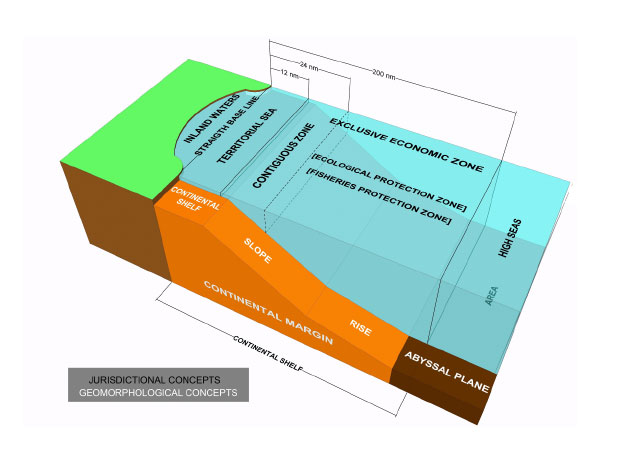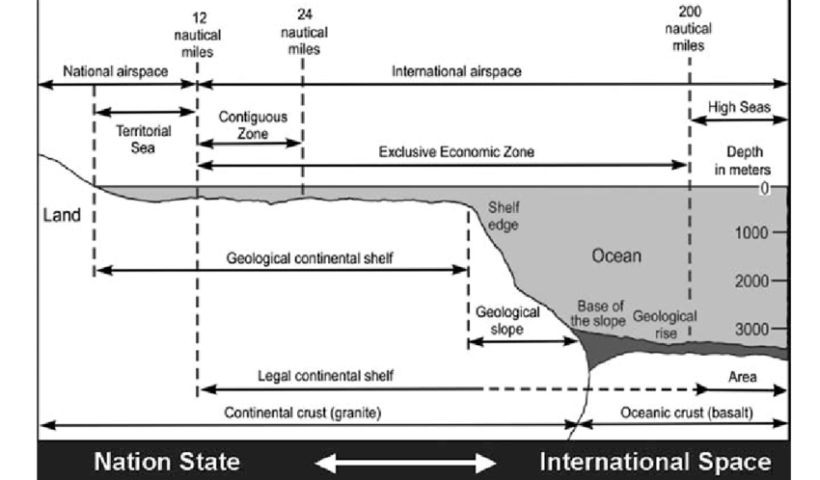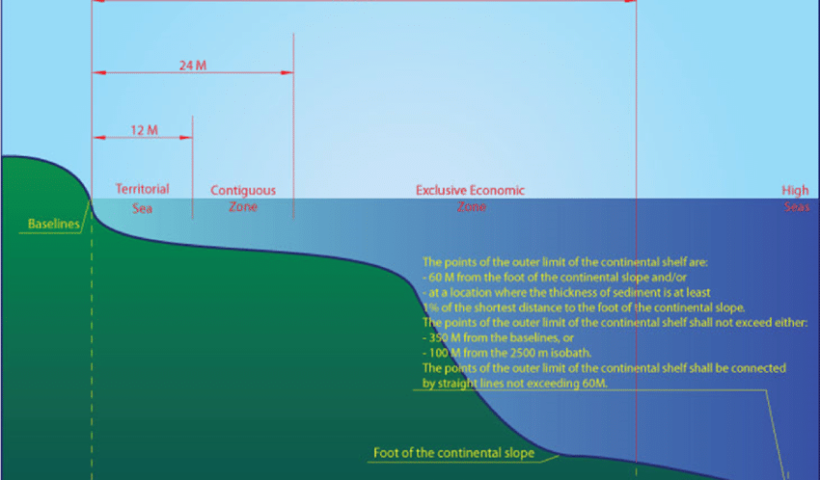Coastal states can claim five key maritime zones. Proceeding seawards from the coast they are internal waters, territorial seas, the contiguous zone, the exclusive economic zone (or, in some cases, an exclusive fishing zone) and the continental shelf. Archipelagic states may also claim archipelagic waters within their archipelagic baselines. Beyond these national zones of jurisdiction lie the international maritime zones of the high seas and the Area.
The rights of the coastal state and aliens vary in these maritime zones, and do so both spatially and functionally. Thus, the coastal state has more rights closer to shore, for example in internal waters and the territorial sea. Aliens retain considerable rights within a coastal state’s claimed maritime zones concerned with communication issues such as navigation, overflight and the laying of submarine cables and pipelines. The coastal state, in contrast, boasts significant resource related rights, particularly concerning fishing and mineral extraction from the seabed.
Tag: contiguous zone
International Law in the South China Sea
International Law in the South China Sea, artificial islands, Commission on the Limits of the Continental Shelf, contiguous zone, continental shelf, Convention on the Continental Shelf, Convention on the High Seas, Convention on the Territorial Sea, EEZ, exclusive economic zone, internal waters, ISLANDS, low-tide elevations, maritime zones, rocks, south china sea, South China Sea dispute, UNCLOS I, UNCLOS II, UNCLOS III
View More International Law in the South China SeaCONTIGUOUS ZONE at the sea, in customary international law and LOSC
The Concept of the Contiguous Zone
The contiguous zone is a marine space contiguous to the territorial sea, in which the coastal State may exercise the control necessary to prevent and punish infringement of its customs, fiscal, immigration or sanitary laws and regulations within its territory or territorial sea. . CONTIGUOUS ZONE at the sea, in customary international law and LOSC, Concept of the Contiguous Zone, contiguous zone, EEZ, enforcement jurisdiction in its contiguous zone, High seas
Typology of Marine Spaces
In summary, spatial jurisdiction comprises both complete spatial jurisdiction (= territorial sovereignty) and limited spatial jurisdiction (= sovereign rights). In either case, it must be stressed that coastal State jurisdiction over marine spaces is spatial by nature. It follows from the above discussion that marine spaces in the law of the sea can be categorised as follows :
(i) Marine spaces under national jurisdiction
(a) Marine spaces under territorial sovereignty (or complete spatial jurisdiction): internal waters, the territorial sea, international straits, and archipelagic waters.
(b) Marine spaces under sovereign rights (or limited spatial jurisdiction): the contiguous zone (where the EEZ is established), the EEZ and the continental shelf.
(ii) Marine spaces beyond national jurisdiction the high seas and the Area., Typology of Marine Spaces, archipelagic waters, beyond national jurisdiction, contiguous zone, High seas, internal waters, international straits, jurisdictional zones, national jurisdiction, territorial seas, Typology of Marine Spaces
MARITIME ZONE AND JURISDICTION
MARITIME ZONE AND JURISDICTION, contiguous zone, continental shelf, Exclusive Economic Zone (EEZ), High Seas and Deep Ocean Floor, internal waters, law of the sea, Maritime Claims, maritime zone, Maritime Zones and How They Are Determined, River Mouths, territorial sea
View More MARITIME ZONE AND JURISDICTION




